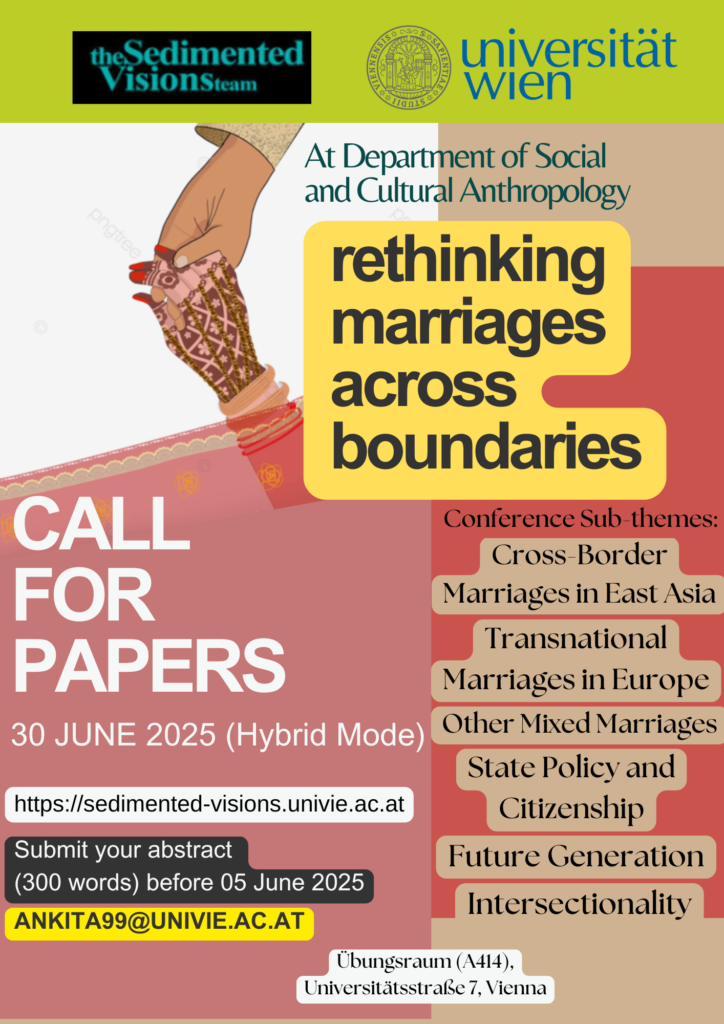
- Call for papers abstract (max 350 words): before 5th June 2025 at ankita99@univie.ac.at
- Announcement of selected papers: 10 June 2025
- Venue: Department of Social and Cultural Anthropology, University of Vienna, NIG -Universitätsstraße 7 / 4th floor, Übungsraum A 414, 1010 Vienna
- In partnership with: “Sedimented Visions” project team, Department of Social and Cultural Anthropology, University of Vienna (https://sedimented-visions.univie.ac.at/people/)
- Participants: Master/PhD students, and Post-docs across subjects
click here for abstract and further information
Abstract
Between 1960 and 2000, the percentage of women in international migration doubled to 48.6%, and in East Asia, it reached 53.2% in 2017 (Momesso, 2020). Cross-border marriage migration, in which females are of the largest proportion, is a growing phenomenon in East Asia, shaped by socio-economic disparities, demographic imbalances, and gendered cultural expectations. It is a huge phenomenon in China, Taiwan, South Korea, Japan, and Hong Kong (Kim, 2013). In South Korea, cross-border marriages have been on the rise due to demographic imbalances and economic factors, with many brides coming from Southeast Asian countries (Bélanger, & Wang, 2012). Similarly, Japan has seen an increase in cross-border marriages, particularly involving women from China, the Philippines, and Thailand. Hong Kong also experiences a significant number of cross-border marriages, often involving women from mainland China and Southeast Asia.China is both a sending and receiving country for brides, juxtaposed with Taiwan’s position as a key destination for foreign brides, particularly from Southeast Asia. While China’s internal and transnational marriage migration patterns have been largely driven by the consequences of its historical one-child policy and rural-urban disparities, Taiwan has experienced an influx of brides from Vietnam, Indonesia, and mainland China due to its gender imbalances and economic dynamics (Fan & Huang, 1998; Hsia, 2007). According to the Taiwanese Ministry of the Interior, as of 2020, there were approximately 500,000 foreign-born spouses in Taiwan, with Vietnamese and Chinese brides making up the majority (Lan, 2024).
Beyond the experiences of migrant brides, the future of their children remains a critical research area. In Taiwan, approximately 200,000 children are born to cross-border marriages, constituting nearly 10% of the school-age population (Li, 2020). Studies have examined school performance among the children of cross-border marriages, revealing disparities in
language proficiency, social integration, and academic achievement. While some research has highlighted their resilience and adaptive capabilities, further inquiry is needed on self-identity formation, community perceptions, and long-term social mobility. Emerging research highlights the shifting attitudes of host societies towards cross-border marriages and the evolving identities of second-generation children (Lan, 2024). The question of whether these communities are becoming more accepting and how this might impact future marriage migration patterns is worth exploring.
The conference will provide a platform to discuss the broader implications of cross-border marriages in East Asia. This includes the role of legal frameworks, media portrayals, and social support systems in shaping the experiences of marriage migrants. Emerging themes such as the commoditization of brides, human trafficking, and the socio-cultural integration of migrant families will also be addressed. It would provide a valuable platform for emerging scholars to present their research, exchange ideas, and collaborate on innovative approaches to understanding cross-border marriages. It will foster interdisciplinary dialogue and encourages the integration of diverse perspectives, which is essential for comprehensively addressing the complex social, economic, and cultural dynamics of these marriages.
Thus this abstract proposes a research conference at the Department of Social and Cultural Anthropology, University of Vienna, to address these key themes. The conference will explore sub-themes, not limited to, including:
a. Cross-border marriages in East Asia
b. Transnational/International marriages in Europe
c. Cross-regional marriages in South Asia (India)
d. State migration policy and citizenship issues
e. Future generation and prospects
f. Self, Identity, and Intersectionality
